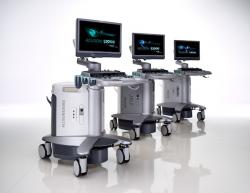
The HELX (say ‘helix’) Evolution of the ACUSON S Family of ultrasound systems from Siemens is powered by the new SieStream HD system architecture to offer HD image quality, streamlined workflow and cost-effective sustainability and upgradability. It features new transducers, more powerful image processing and a 21.5-inch LCD monitor with a 60 percent larger image area.
“We wanted to move the technology forward but we wanted to bring our installed base with it,” said Bundy. “It’s an upgrade for our existing customers and a radical change as well because 80 percent of the hardware is different. We have an HD monitor where we just had an HD transducer before. It will be very economical for existing customers to move forward with the latest technology.”
Bundy described three areas of improvement. “One is image quality improvements; we’ve spent a lot of time on that. Second is the area of workflow. We’ve provided more intuitive controls and made it easier for operator to handle the keyboard, watch the clinical information on a screen and monitor the patient. The third area is sustainability. The hardware is predominantly recyclable, but more important is knowing that something you bought a couple of, even five, years ago can be upgraded to the latest, greatest technology. In today’s environment, more economical solutions are important to our customers.”
With a common architecture across the entire ACUSON S Family of systems, the HELX Evolution provides the flexibility and forward compatibility to add new pioneering technologies as they become available. Bundy said Siemens’ elastography and tissue strain technologies are further enhanced with the HELX Evolution. Virtual Touch imaging (VTi), Virtual Touch quantification (VTq),10 Virtual Touch IQ (VTIQ) as well as eSie Touch (cute: eSie = easy) elasticity imaging offer a revolutionary way of visualizing and measuring tissue stiffness, allowing clinicians to evaluate anatomy more clearly than ever before. Two of the three Virtual Touch technologies have been approved by the FDA; VTq is pending.
Bundy said the changes were market-driven. “Everyone is looking for the most economical way to move forward,” he declared. “We have a very active process of collaboration with customers. There’s a lot of talk here at RSNA about partnerships. We’re also trying to drive the market.”
Bundy also let me in on an innovation that was secret within the company until a few days ago. Called “eSie Image,” it answers the demand of how different each patient is and how to account for that in adjustment of imaging. “With eSie Image software we can do real-time adjustment of the imaging,” he explained. “We can get a good image quickly and adjust as the transducer moves around the body. It takes workflow to a new level.”
Thanks for stopping by, Jeff!
Click here for more information about Siemens at RSNA:
Disclaimer: Mr. Goldstein is paid by Siemens Healthcare for his reporting on RSNA.

